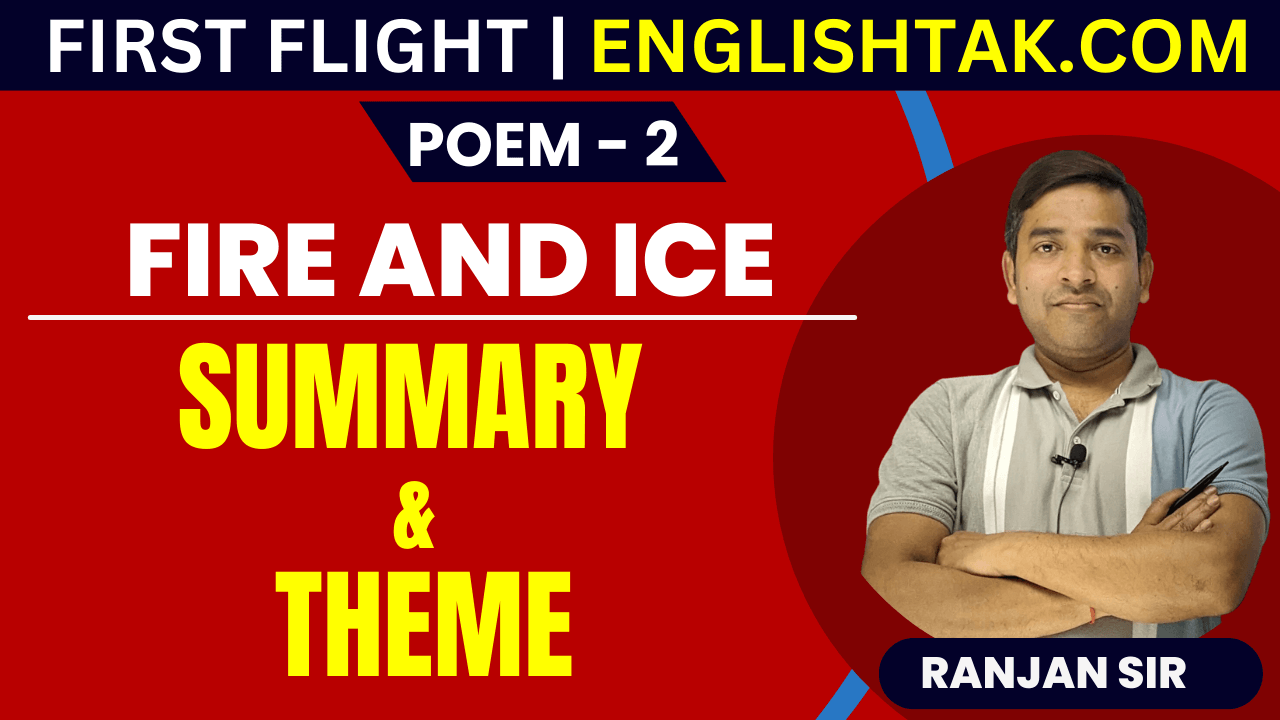![]()
Fire and Ice Poem Summary and Theme
Table of Contents
Fire and Ice Poem Summary and Theme – The complete summary and Theme of CBSE class 10 Poem in English. CBSE Class 10 NCERT Poems Solution.
Fire and Ice Poem Summary and Theme
1. Destruction through Desire (Fire):
Fire symbolizes intense emotions such as greed, lust, and desire. Frost suggests that uncontrolled desires can consume people and cause harm to society, potentially leading to catastrophic outcomes. Just like fire spreads and burns everything in its path, human desires, if unchecked, can lead to self-destruction.
2. Destruction through Hatred (Ice):
Ice represents cold emotions like hatred, indifference, and cruelty. The poem shows that these emotions, though less intense than desire, can be just as destructive. Frost compares hatred to ice, which numbs and eventually freezes, signifying how hatred can gradually destroy relationships and societies.
3. Duality of Human Nature:
The poem highlights the duality of human emotions and their potential to cause destruction. Whether through fiery passion or icy indifference, both extremes can have devastating consequences. This reflects the idea that human beings are capable of both passionate and cold-hearted behaviors, both of which have the power to harm.
4. The End of the World:
While Frost presents the literal end of the world, the poem is also a metaphor for the emotional and moral collapse of humanity. The world could end in a physical sense, but it can also symbolize the breakdown of human relationships and society due to unchecked emotions.
Poem Explanation in Points – Fire and Ice Poem Summary and Theme
“Fire and Ice” by Robert Frost is a short yet profound poem that reflects on the potential end of the world and explores powerful human emotions. Here’s a detailed summary:
The poem opens with the speaker contemplating two possible ways the world could end: either in fire or in ice. These two elements are not just physical forces but also symbolic representations of human emotions. Fire represents desire, passion, and greed, while ice symbolizes hatred, coldness, and indifference.
Fire as a Symbol of Desire:
In the first part of the poem, the speaker aligns with those who believe the world will end in fire, symbolizing desire. Desire can be interpreted as intense human emotions like lust, greed, and ambition. These are destructive forces that can consume individuals and societies. The speaker acknowledges that desire, much like fire, can spread uncontrollably, causing destruction on a large scale. Frost suggests that unchecked desire is enough to bring about the world’s end.
Ice as a Symbol of Hatred:
In the second part of the poem, the speaker mentions the alternative view: that the world could end in ice. Here, ice symbolizes coldness, hatred, and apathy. Unlike the fiery passion of desire, ice represents a more slow, gradual form of destruction—indifference, cruelty, and emotional detachment. These cold emotions can freeze relationships and humanity, leading to destruction over time. Just as fire can burn, ice can freeze and shatter.
Dual Nature of Destruction:
The speaker concludes that while fire (desire) is destructive, ice (hatred) is equally capable of causing the world’s end. This duality reflects the idea that both extremes—excessive passion and extreme indifference—are dangerous. Frost suggests that while desire might burn the world in one way, hatred can equally destroy it in another. The two forces are presented as equally powerful and equally capable of devastation.
Deeper Meaning:
On a broader level, “Fire and Ice” reflects on the destructive potential of human emotions. Frost isn’t simply talking about the physical end of the world; he is also addressing the internal destruction caused by emotional extremes. Both fire (desire) and ice (hatred) are parts of the human condition, and they can lead to the downfall of individuals, societies, and even the world.
Structure and Style:
The poem consists of just nine lines, using a simple and concise rhyme scheme (ABAABCBCB). The brevity of the poem mirrors the stark nature of its message. Frost’s use of plain language and sharp imagery (fire and ice) makes the poem direct and impactful, while the rhyme scheme gives it a rhythmic flow.
Overall Message: Fire and Ice Poem Summary and Theme
“Fire and Ice” presents a meditation on the destructive capacities of human nature. Whether through the intensity of desire or the coldness of hatred, both emotions can lead to the end of things. Frost leaves the reader with the understanding that extreme emotions, left unchecked, can have catastrophic consequences, and ultimately, both fire and ice are forces to be reckoned with.
In conclusion, “Fire and Ice” is a reflection on the destructive potential of human emotions and the dangers of both passion and apathy, capturing profound insights in just a few short lines.
Fire and Ice Poem Summary and Theme
The poet is certain that humanity will be destroyed one day. He discusses two different beliefs about how the world might end, based on people’s opinions. The poet sides with those who believe the world will end in fire. He supports this view because he has seen the damaging effects of uncontrolled desires on human life. He compares human desires to fire, as both can grow uncontrollably and cause destruction. This fiery passion, if left unchecked, could be a major reason for the end of humankind and the world.
On the other hand, the second belief is that ice could also bring about the world’s destruction. The poet compares ice to hatred. Just as ice can numb the body, hatred can numb the mind and emotions, making people cold and cruel. This cruelty, driven by hatred, could be even more harmful to humanity than desire.
The speaker introduces us to the debate between two groups of people: one group thinks the world will end in fire, and the other believes it will freeze. The poet could be referring to the literal end of the world, but he is also talking about how humans have the power to destroy each other.
The poet has experienced the passionate emotions of desire, like love and lust, which could potentially turn the world into a fireball. However, he has also seen the destructive power of colder emotions, like hatred. While love gets more attention, hatred works silently, causing destruction in a more subtle but equally powerful way. It may not be as dramatic as fire, but it can still lead to the same outcome.
Conclusion:
The poem focuses on the idea that human emotions, whether driven by desire or hatred, have the potential to destroy the world in two different ways.
English Solution for Class 10 Board Exams
Dust of Snow Theme Summary and Explanation
Two Stories about Flying Very Short Questions Answers
Unseen Passage for Class 10 with Answer PDF 2025
Fill in the Blanks with Suitable Words
Complaint Letter Class 10 Solved Exercise
How to Write Analytical Paragraph Class 10





